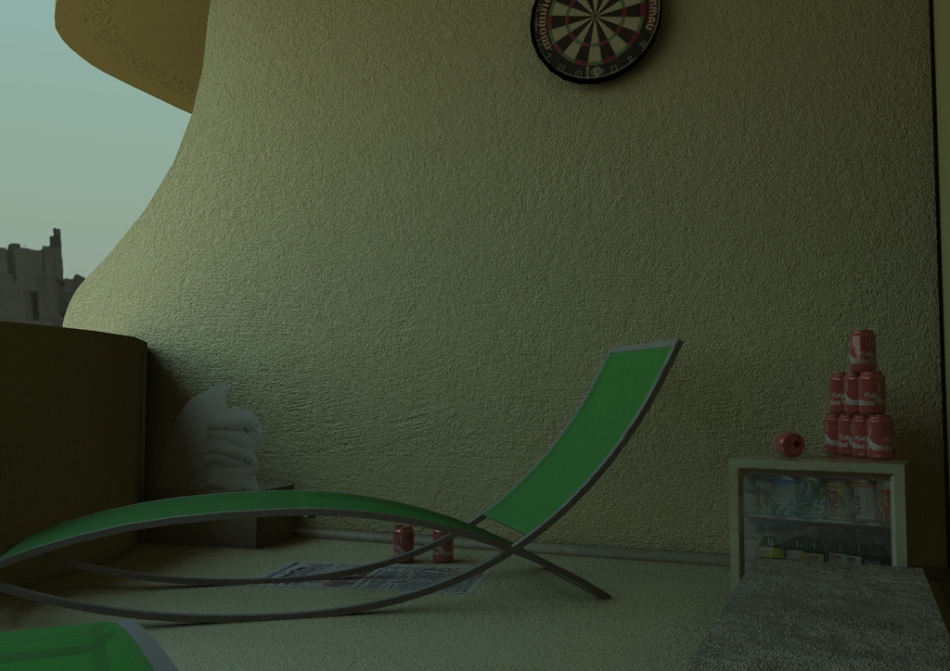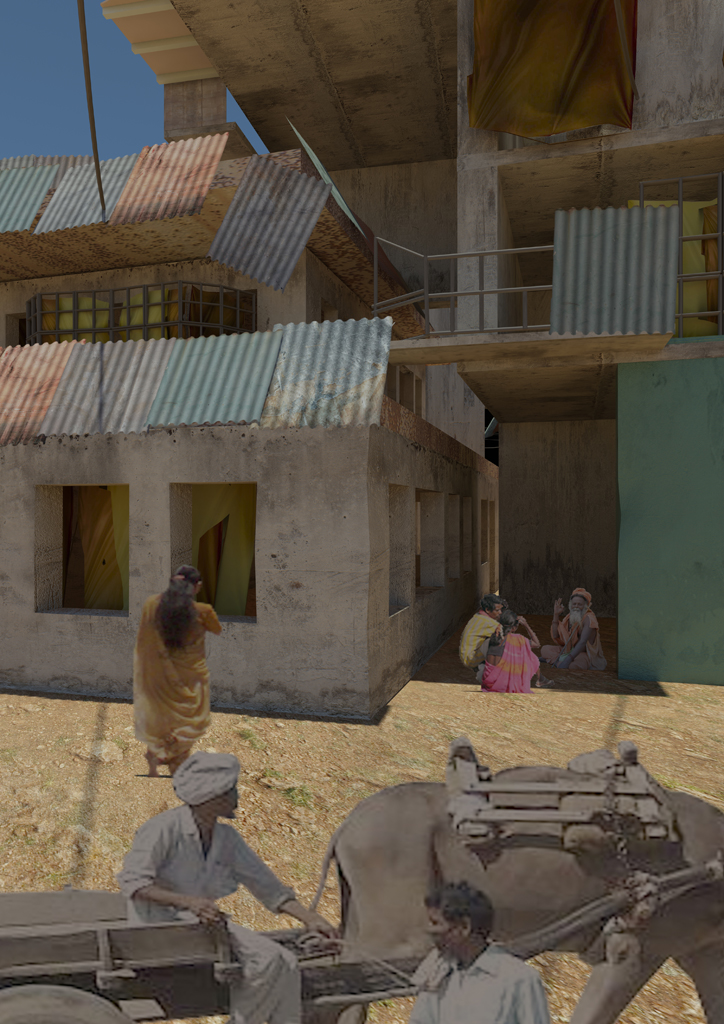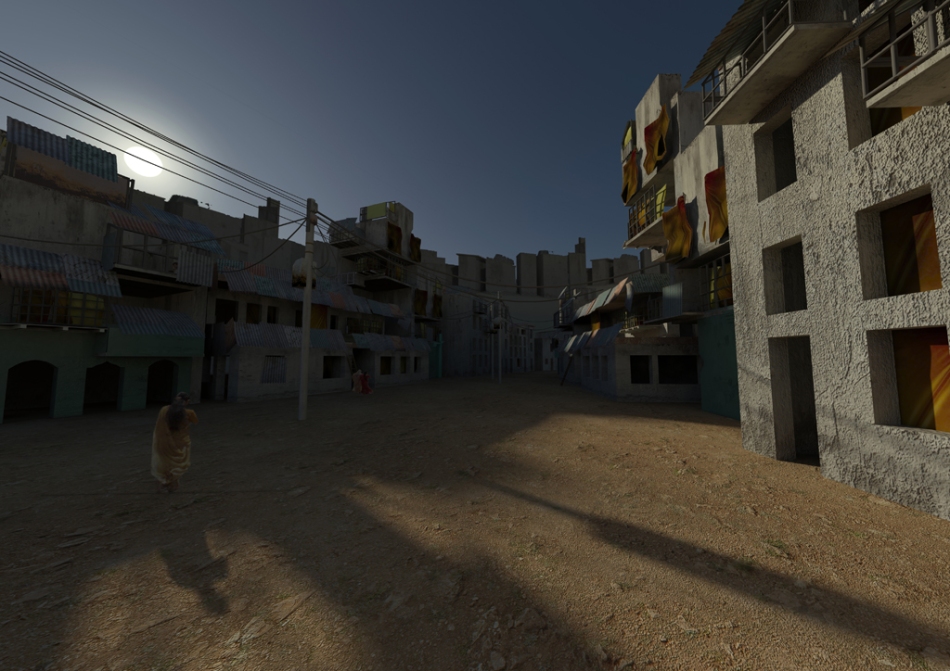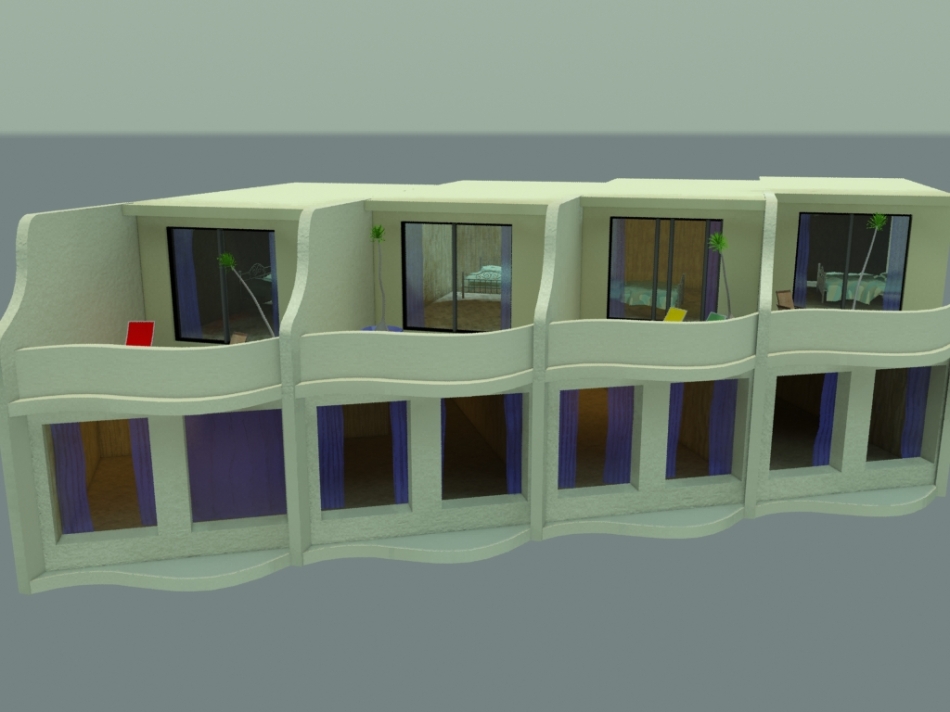Place Non-place and Mutability in the Intimate Metropolis
This is a link to the supplementary essay that supports my Fourth project.
Place NonPlace Mutability in the Intimate Metropolis.pdf
You will need a PDF reader to open this file.
Art Under The Bridge
I’m still thinking about what to put in the foreground. A ladder with some cans surrounding it where the artist was working until he or she decided to take the picture that you see? A cyclist going by on the cycle path. I need some traffic still. I’m not sure about the buildings on the right hand side, they don’t have the authenticity of the ones on the left. I am really happy with the way the scaffolding has turned out on the left.
Final Street Scene
This is the final street scene with an appropriate level of DOF, masked AO and the odd touch up.
I am really happy with the results now.
🙂
Online Survey
The questionnaire I have prepared is up and running, initially for a month from 11th Feb to 11th March 2010.
Questionnaire: http://www.kwiksurveys.com/online-survey.php?surveyID=CIKMJ_907c39d4
Results: http://www.KwikSurveys.com/results-overview.php?surveyID=CIKMJ_907c39d4&mode=4
I have posted in in the discussion forum on two LinkedIn groups that specifically deal with 3D Visualisation. Many of the people in these groups are either working in the field right now or are students who are interested in working in this area – both are appropriate candidates for this survey.
Hyper-reality “The simulation of something which never really existed.”
I have been wanting to define Hyper-reality for a while now and having looked through the three books I have about Baudrillard I have come to this conclusion:
“Hyper-reality is the reality which is ‘more real that real’, fed to us by a range of media forms that we generally believe to be the truth. This hyper-reality is a simulacrum in the sense that it is a copy of reality which hides the fact that it itself is not real. i.e. It is pretending to be the real when infact it is not.”
Baudrillard seems to focus on the media when talking about hyperreality and this interests me because it provides a context for all the promotions and advertising that we are bombarded with on a daily basis. In terms of 3D architectural visualisation work I think this naturally falls into the category of Hyper-reality. The work displayed is created to represent entirely new projects or alterations of existing structures so that building planners, investors, local councils and the general public can see (or visualise) the intended building before a brick has been laid. So Architectural visualisations are realer than real and due to their “perfect” visual quality are simulacrums of the real buildings. The weathering and aging processes that the building becomes involved in once constructed in a real environment aren’t reflected in 3D architectural visualisations, also the actual use of the building in many cases changes its appearance from the original visualisations as visual cues of occupancy and habitation appear.
Horrocks.C. & Jevtic.Z., 1999, Introducing Baudrillard, Icon Books
Baudrillard.J., 1994, Simulacra and Simulation, The University Of Michigan Press
Proto.F., 2006, Mass Identity Architecture – Archtectural Writings Of Jean Baudrillard, Wiley-Academy
Hotel Balcony Composite
This render is a final render of this balcony. I have adjusted the camera height so that the focalisation of the scene is from an occupants point of view. This creates the feeling of presence in the viewer and a sense of implicit involvement in the scene. The items in the scene have been re-arranged so that they are used to better effect.
Renders for current project (updated)
I started using Layers to organise the main model, the second row of buildings and then the background flats and the occupation signifiers in the scene. It made it much easier to manage the scene and considering that I use layers in all the other apps I know I’m not sure why I didn’t think to look for them earlier. I think my attention got diverted by the way you can spin a model around in max. Layers fundamentally is the same but feels more like a way to hide things you don’t need right now in order to simplify what you’re looking at rather than the central core of object management like in Photoshop. I really need to get another monitor the layers palette is a pain in the rear. You need it fat more often than you think and its not just like the Materials and Render dialogs that you can open up as and when you need them because of the function they provide.
This render took two days to organise but now thats done the next ones are coming along far quicker (see further down the post.)
This last one ^^^^ has an Ambient Occlusion pass applied to it in Overlay mode, but the Fill level has been reduced in order to balance the result correctly.
Preparing scenes
The position of the camera in a scene can create opportunities to involve the viewer in the work or to seperate them from the work to reduce personal involvment in the scene and create a more objective viewpoint.
In all cases the positioning of the camera needs to be done with purpose and intent.
In Narrative & Media there is a list of signifiers that give meaning to the position of a camera in a scene. All of them make good sense when you consider examples from movies, TV and photographs you have taken or have looked at.
Four of my favourites are:
- Medium Shot: Involvement, Internal Focalisation.
- Long Shot: Distance, Context, External Focalisation.
- Close Up: Intimacy, Internal Focalisation.
- Big Close Up: Emotion, Internal Focalisation.
The Focalisation indicates whether you as the viewer are likely to feel that you are involved in the scene (internal) or not involved in the scene (external).
The book goes into further detail about Focalisation, but I am still reading up on that. This small amount of information is making a big difference on my choice of camera angles. I think I need more practice, but its interesting all the same.
Current renders:
The Room scene shows how the individual is protected from the outside world by the corners that surround them. The window becomes a vantage point from which to safely observe the surrounding world from the safety of your nest.
Currently…
I am rendering a balcony scene that shows signals of occupation. I’m going to run an Ambient Occlusion pass and overlay it in Photoshop. On top of this I’m going to add a photo background in the very small areas left that show the rest of the world. This will be one of the final renders will be shown at the presentation.
Occupational Signals : Models
These are the models that I will use to indicate occupation in the scenes. Some of these items I have created, some I have used (under a free licence for use) from the websites artist-3d.com and turbosquid.com. If I have used your model, please accept my gratitude. 🙂
Occupancy & believability test.
A few months ago I went to the NTU Architecture final year degree show in London “Nott to scale” with a colleague of mine. The one thing that I brought back with me is the way that they superimpose people into their scenery. Initially I thought that hardly any of the students had put any time into this particular part and in some cases it actually took away the effect of some of their amazing work, which obviously is a shame. However I have just spent the last hour and a half or so superimposing and here are the results.

Blimey! not bad at this size, if I do say so myself !
9/9/9 Tutorial
Points discussed during the tutorial include:
- Camera placement for scene composition should aim to include Tertiary, Secondary and the Primary object of focus.
- I should grid my scene by the square inch (roughly) and ensure that there is valuable content of interest in each square. I need to aim for 5% sky too !
- I should refrain from overworking the structure and use a simpler and quicker method of creating the shell of the buildings that I want in the scene (see Gallery images).
- I should use the repetition model of the hotel with some kind of separation device (eg a pathway and fence) in front of it to create the perception of the perimeter of the hotel grounds.
- In the scene the left will focus predominately on the structure the right can focus predominately on occupation.
- To fin the mr Rendering error (see previous post) I can either remake the electric lines and use the Generate Mapping Coordinates tick box or use the Normals modifier to unify the normals in the loft.
- Ideas for occupation: Trellis, plants, motorcycle etc. Each flat has a different person in it! Make it look that way!
- Remember to make an ambient occlusion composite of the scene just before adding the people in PS.
- When making windows, delete the polys to create the gap and then use the Border poly editing tool to select the edges of the window and then use Bridge to create the window cill rather than extruding the inside through the gap and then usiing Vertex Snap to align the verts in to place.
- Realism is for documentary images where accuracy is important.
- Believeability is for pushing the boundary of what people will consider to be Dramatic and impressive.
- “That must have taken YOU ages” vs “Thats fantastic! Look at how the ….” The image has presence and demands to be noticed in its own right. (eg without reference to the artist.)
- I should bring my Balchelard work together with my Modelling. (Its currently miles apart!!!) (damn!)
- Remember to use “Interpolation steps ” when creating bezier wall lines for extruding. This prevents blocky ambient occlusion too.
I was set an exercise to create “crazy spaces” these are the results. I have found it more fun to create exterior spaces rather than interior as you can see.
During the tutorial we briefly discussed the issue that I am modelling exterior sspace yet reading Balchelard who wrote about interior space. I need to write, justify and illustrate what I understand about Interior vs Exterior (good title) prior to the presentation for this section.
These are the spaces I created during the exercise. Each one shows the shape first and then a couple of views from the inside. All with AO as the overiding material so that I can see the corners more dramatically / effectively.
Number 13 is the best composition in terms of the camera angle and interest available in the scene. Ambient Occusion creates a fantastic effect!
Mock up for tutorial

With the mr Ambient Occlusion light shader applied (just to see what it does).

and without it.
With the AO light shader applied the scene looks like it belongs in a computer game and is far less realistic. Although I can imagine that Ambient Occlusion is very useful for evening scenes.
Things I have down to do but are not yet done:
Write up my research on Balchelard.
Write up how it applies to my work by linking it to the current piece in progress.
Make a Cyclorama for the background.
Add dirt and more detail (several rounds of this).
Write up the list of occupancy signals and check that they are all applied to the scene.
Write up the lists of common building materials found in India.
Write up the analysis of my research images.
Write up the analysis of proximity of the different buildings in the images I have.
Use photoshop to place people into the scene in appropriate places to bring the scene to life and suggest occupancy in the strongest way possible.
Find an appropriate HDR image to get the very best out of the scene once complete.
Also I need to adjust my proposal hopefully to get more time to complete this as I think the end of September is pushing it now.















































